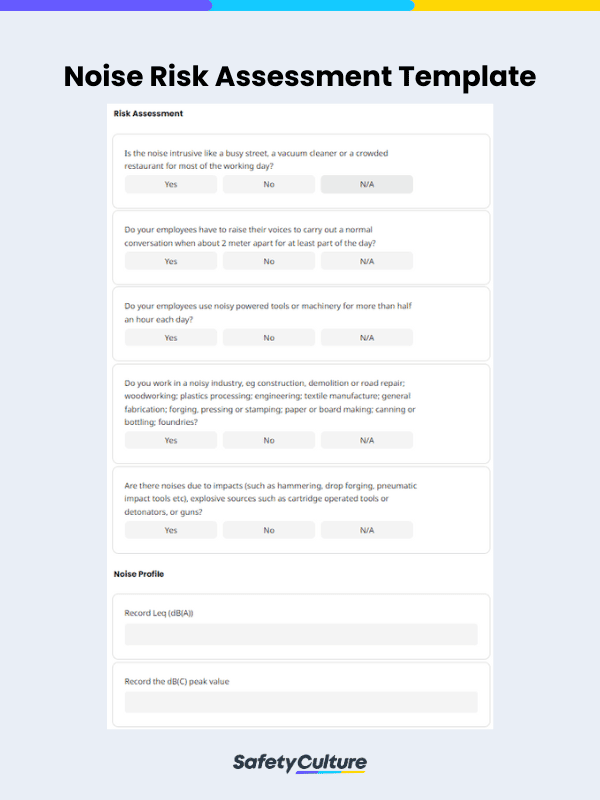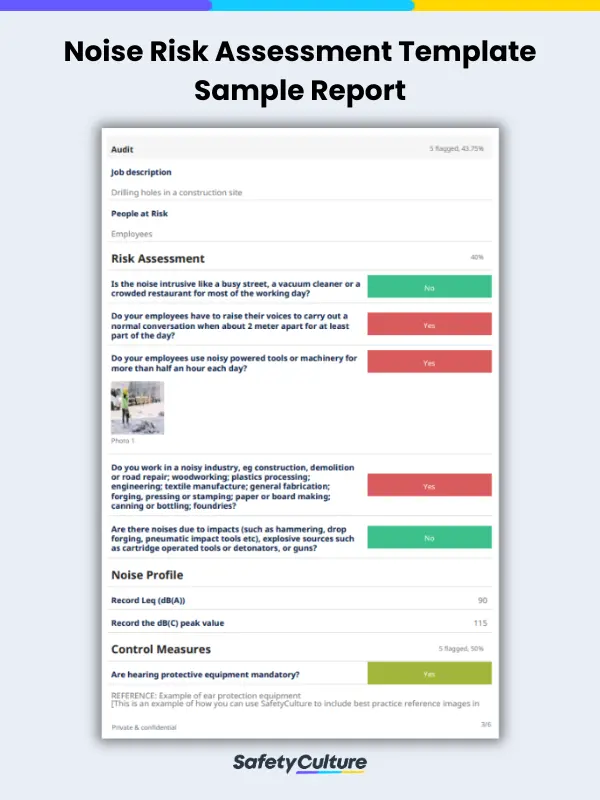What is a Noise Risk Assessment?
A noise risk assessment is performed to ensure the health and safety of workers exposed to noise risks. Performing noise risk assessments help identify sources of noise risks and how they affect employees. Key findings from the assessment are then evaluated to develop preventive measures or corrective actions to protect workers from the long-term adverse effects of noise exposure.
What is a Noise Risk Assessment Template?
A noise risk assessment template is a tool used by organizations to assess and evaluate potential risks associated with noise exposure in the workplace. It typically includes a series of questions, prompts, or sections that allow the individual conducting the assessment to gather information about the nature of the noise sources, the duration and intensity of exposure, and the potential impact on workers’ health and safety.
The template can be customized to suit the specific needs of the organization and the nature of the workplace, such as manufacturing facilities, construction sites, or offices. It’s an important tool for employers to comply with occupational health and safety regulations, protect their workers from potential harm due to noise exposure, and create a safe and healthy work environment.
Why Use a Template for Noise Risk Assessments
Using a template for noise risk assessments offers various advantages:
- Consistency – A template provides a standardized format for conducting noise risk assessments across an organization, ensuring that the same criteria and guidelines are applied consistently across different assessments. This helps to ensure that all relevant aspects of noise risk are considered and that assessments are conducted in a consistent and thorough manner.
- Efficiency – Using a template can help save time and effort compared to starting from scratch for each assessment, as the template serves as a reference and checklist, too.
- Accuracy – It can prompt the assessor to collect data and information in a systematic and comprehensive manner, reducing the risk of overlooking important factors or making errors in the assessment process.
- Documentation – Completed noise risk assessment reports serve as documentation of compliance with regulatory requirements and a reference for future assessments or audits.
What to Include in a Noise Risk Assessment Template?
A basic noise risk assessment includes regular checking and details of the following aspects:
- Job description (e.g., core drilling)
- Specific people/personnel at risk
- Noise risk assessment
- Details about the noise (record leq, peak value)
- Control measures (including the use of Personal Protective Equipment or PPE such as hearing protection)
- Overall risk assessment
- Recommendations
- Name and signature of inspector
How to Effectively Perform a Noise Risk Assessment: A 4-Step Guide Using a Template
- Identify – Do a site check and observe where there may be a risk of noise exposure. Determine a reliable estimate of employee exposures, actions to perform in order to comply with the law (i.e., noise control measures and worker protection), and employees who need health surveillance.
- Evaluate – Evaluate and provide an overall risk rating for each risk identified during a site check. Assess if current preventive and control measures are being followed or complied with.
- Implement control measures – After recording findings, create an action plan for items or areas identified as non-compliant or needing corrective actions to comply with the law. Set an action, assign a responsible person to do the work, and set a due date using a noise risk assessment template.
- Monitor – Conduct a regular review to monitor if set controls for noise risks are consistently implemented. Monitor the workplace and conduct regular noise risk assessments to easily identify early signs of adverse effects that may be caused by occupational noise exposure.
FAQs About Noise Risk Assessments
The US Occupational Safety and Health Administration (OSHA) establishes a permissible exposure limit (PEL) of 90 decibels for all workers over an 8-hour shift. The OSHA standard also mandates that employers implement a hearing conservation program if the average noise level reaches 85 decibels over an 8-hour workday.
Long-term exposure to high levels of noise can cause permanent hearing damage, making it crucial to take preventive measures through regular assessments. Additionally, the harmful effects of excessive noise are not always noticeable, so it is easier to identify and control them through surveys and assessments.
As recommended by the Centers for Disease Control and Prevention (CDC), if complete avoidance of loud noises is not possible, the use of hearing protection devices such as earplugs, ear canal caps, and safety earmuffs is the best way to protect hearing and avoid long-term damage.




